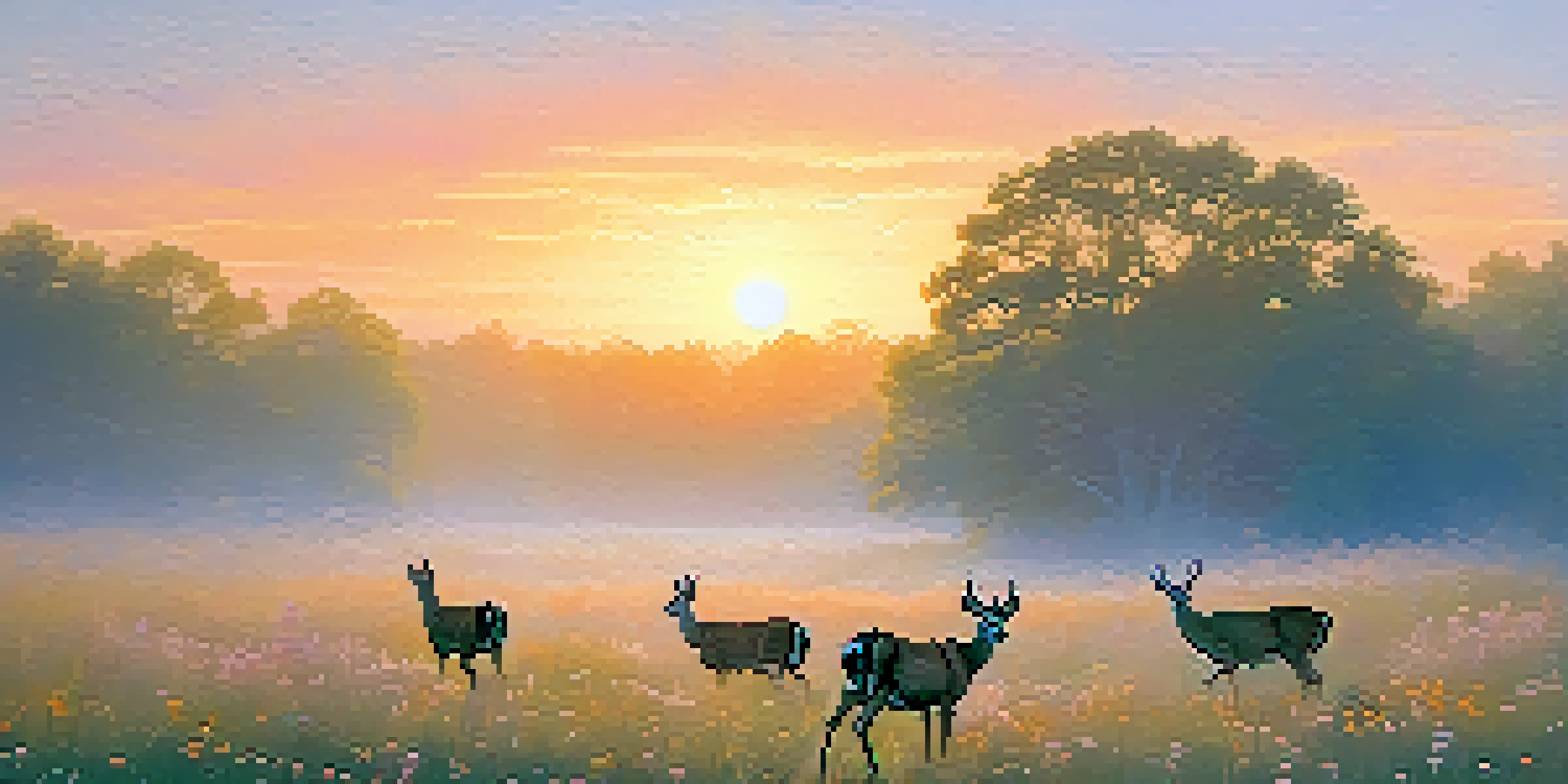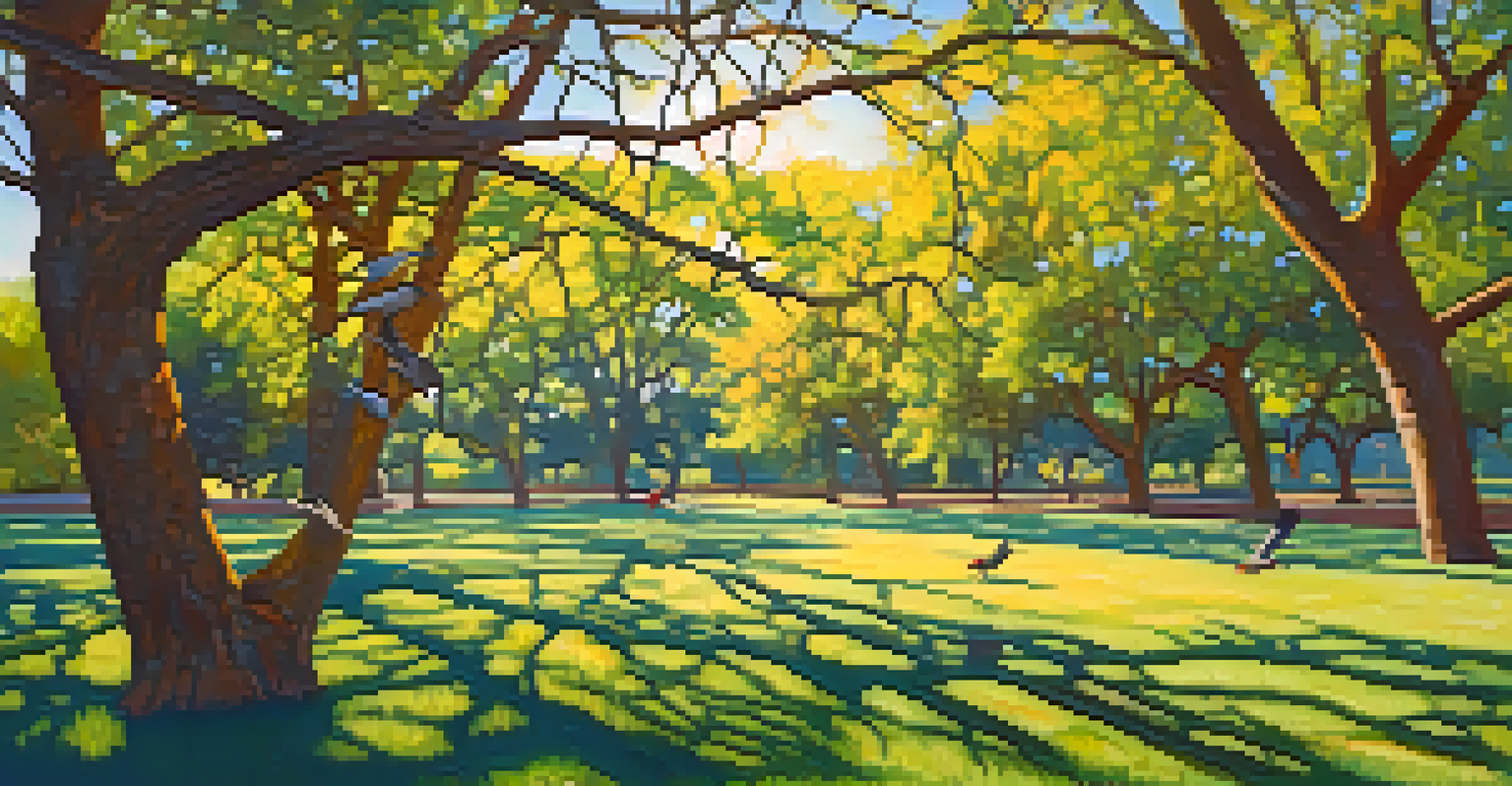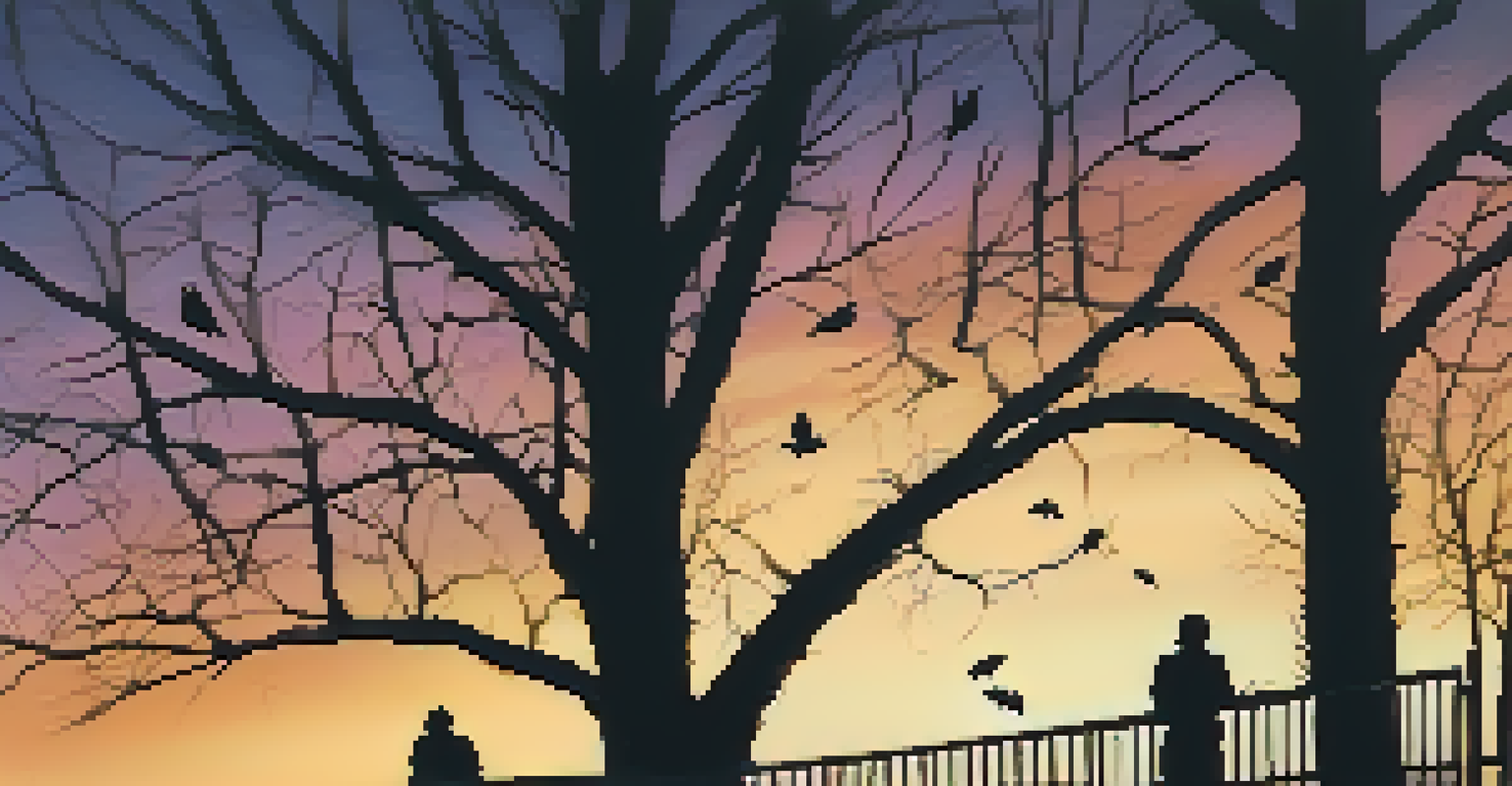Best Times of Day for Observing Austin's Wildlife

Early Morning: The Best Start for Wildlife Watching
Dawn is often heralded as the best time for observing wildlife in Austin. As the sun begins to rise, many animals, especially birds, are most active, singing and foraging for food. The cool morning air creates a peaceful atmosphere, making it easier to spot creatures before the heat of the day sets in.
In every walk with nature one receives far more than he seeks.
During these early hours, you might catch a glimpse of deer grazing in open fields or squirrels darting about as they gather breakfast. The calmness of the morning also allows for better sound, so listen closely for the rustling of leaves or the chirps of hidden birds. It’s a magical time that can make you feel connected to nature right from the start of your day.
Plus, the soft light of dawn can create stunning photography opportunities, perfect for capturing Austin's wildlife in their natural habitat. So grab your coffee, head out early, and enjoy the serene beauty of dawn while observing the lively antics of local animals.
Late Morning: A Time for Bird Watching
As the morning progresses, the activity of wildlife shifts, particularly among birds. Late morning is a prime time for birdwatchers, as many species are still actively searching for food but are more visible as they settle into their midday routines. This period can offer great chances to see a variety of birds perched on trees or flitting about.

In Austin, the diversity of bird species is astounding, ranging from colorful songbirds to majestic hawks. Birdwatching can be a rewarding hobby, and the late morning hours provide a wonderful opportunity to spot different species. Bring along a pair of binoculars and a bird guide to help identify your feathered friends.
Best Times for Wildlife Watching
Observing wildlife is most rewarding during early morning and late afternoon when animals are most active.
Additionally, late morning can be a quieter time for wildlife observation, allowing you to enjoy the sounds of nature without the hustle and bustle of the day. Just remember to stay patient and observant, as the rewards of wildlife watching often come to those who wait.
Afternoon: A Quiet Time for Observing Wildlife
The afternoon sun can create a lull in wildlife activity, but this doesn't mean there’s nothing to see. Many animals seek shade during the hottest parts of the day, making them less visible yet still present. Observing wildlife during this time requires a bit of patience and a keen eye for detail.
Look deep into nature, and then you will understand everything better.
Look for signs of life in shaded areas or near water sources where animals might come to cool off. You may spot a lazy lizard basking in the sun or a rabbit peeking out from behind some bushes. Observing these subtle movements can be just as rewarding as the more active moments of the day.
While the heat can slow things down, it’s also a chance to appreciate the quieter side of Austin's wildlife. Take a break, enjoy the scenery, and keep your senses alert; sometimes the most exciting moments happen when you least expect them.
Late Afternoon: A Second Wave of Wildlife Activity
As the day begins to cool, many animals emerge from their shaded retreats, making late afternoon another fantastic time for wildlife observation. This period often sees a surge in activity as creatures prepare for the evening. It's not uncommon to witness a flurry of movement as animals resume their foraging and social behaviors.
Birds become particularly active again, and you might see them gathering in flocks or engaging in playful displays. This is also a great time to look for mammals like foxes and raccoons that are starting to come out of their daytime hiding spots. The late afternoon light adds a special glow to the surroundings, enhancing your wildlife-watching experience.
Dusk Reveals Nocturnal Wonders
Dusk is a magical time to witness nocturnal animals like owls and bats as they begin to stir.
Remember to keep your distance and observe quietly to avoid startling the animals. With a little patience, you can enjoy the vibrant scenes of wildlife preparing for nightfall, making this a delightful time for nature enthusiasts.
Dusk: A Magical Time for Nightlife Observation
Dusk is often regarded as one of the most enchanting times to observe wildlife in Austin. As the sun sets and the sky transitions to twilight, many nocturnal animals begin to stir, offering a different perspective on the local ecosystem. This magical hour is perfect for spotting owls, bats, and other creatures that thrive in the night.
The fading light creates an atmosphere filled with mystery, and the sounds of the evening—like the calls of owls or the chirping of crickets—add to the experience. Bring a flashlight and keep an eye on the trees and skies; you never know what you might see if you stay still and quiet.
Dusk also brings a unique opportunity to witness the transition of wildlife from day to night. Observing the change in animal behavior can deepen your understanding of their habits and routines, making your wildlife-watching experience even more enriching.
Nighttime: A Different World Awaits
Nighttime opens up a whole new world for wildlife observation, especially in a vibrant city like Austin. Many species that are rarely seen during the day become active, revealing the rich nocturnal life that thrives after dark. With the right gear, you can embark on an exciting adventure to discover these hidden creatures.
Consider exploring areas like parks and nature reserves where you might encounter owls perched silently on branches or raccoons rummaging through leaves. Listening to the sounds of the night can also provide valuable clues about what animals are nearby, as they communicate through calls and movements that are unique to the dark.
Seasonal Changes Impact Activity
Understanding seasonal variations in wildlife behavior enhances your chances of spotting different species throughout the year.
However, remember to take precautions while exploring at night. Bring a flashlight, wear appropriate clothing, and stay aware of your surroundings. Embracing the nighttime wildlife can truly enhance your appreciation for Austin’s diverse ecosystem.
Seasonal Variations in Wildlife Activity
While time of day plays a significant role in wildlife observation, it’s essential to consider seasonal variations as well. Different seasons bring changes in animal behavior, migration patterns, and breeding cycles, which can greatly affect what you see and when. For instance, spring often sees an influx of migratory birds returning to the area.
Summer brings an abundance of life, with many young animals venturing out for the first time. In contrast, fall is a transitional period, offering unique opportunities to observe animals preparing for colder months. Winter may seem quiet, but it can be a great time for spotting certain species that are more visible against the bare landscape.

Understanding these seasonal patterns can help you plan your wildlife-watching adventures more effectively. By aligning your observations with the natural rhythms of the seasons, you can enhance your chances of witnessing the beauty of Austin's wildlife throughout the year.
Tips for Successful Wildlife Observation in Austin
To make the most of your wildlife observation experience, here are some helpful tips. First, always be patient and respectful of the animals and their habitats. Keep a safe distance and avoid loud noises that could startle them. Patience often leads to the most rewarding encounters.
Consider bringing along a notebook or a camera to document your sightings. This can enhance your experience by allowing you to reflect on the different species you encounter and share your adventures with others. Engaging with a local wildlife group can also provide valuable insights and enhance your knowledge.
Finally, don’t forget to enjoy the experience! Whether it’s the thrill of spotting a rare bird or simply the beauty of the setting sun, take a moment to appreciate the wonders of nature. With these tips in mind, you’ll be well on your way to becoming a skilled wildlife observer in Austin.